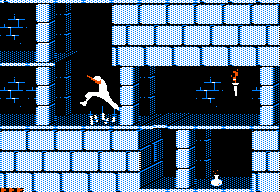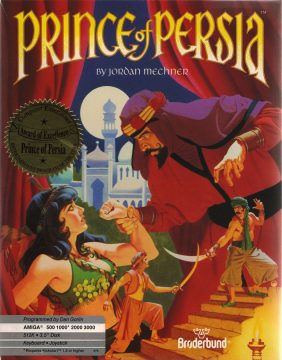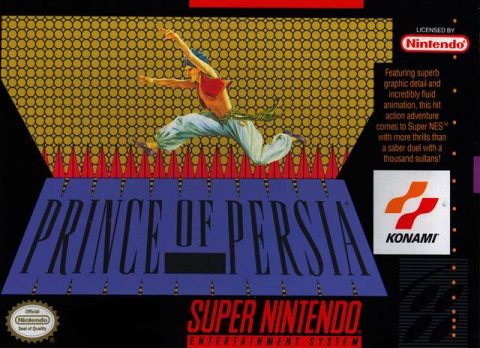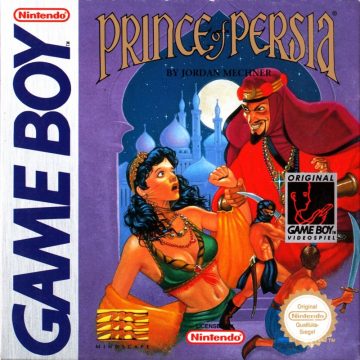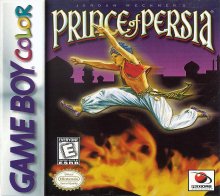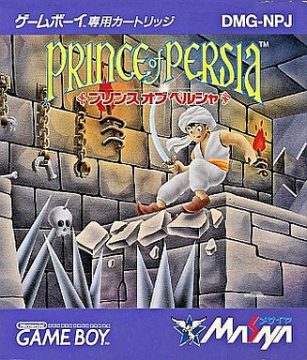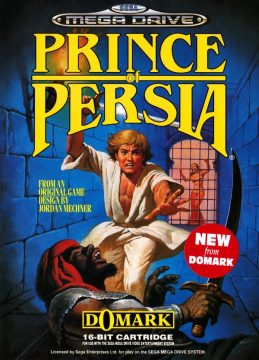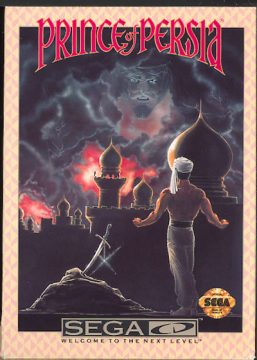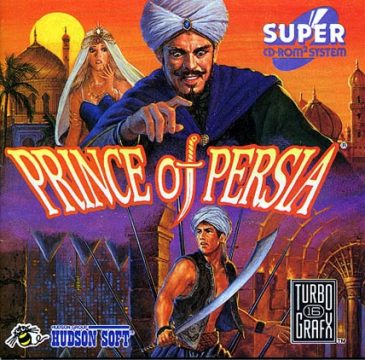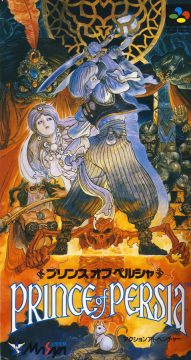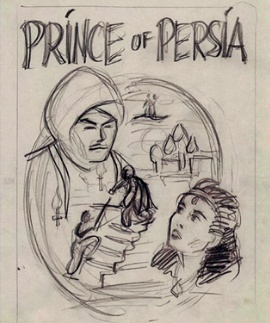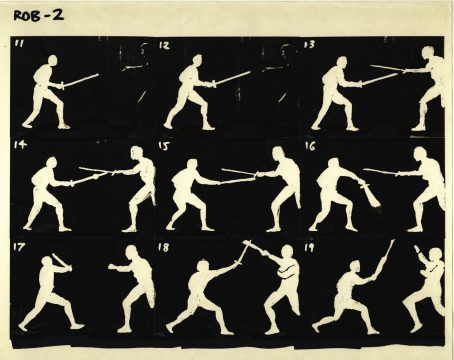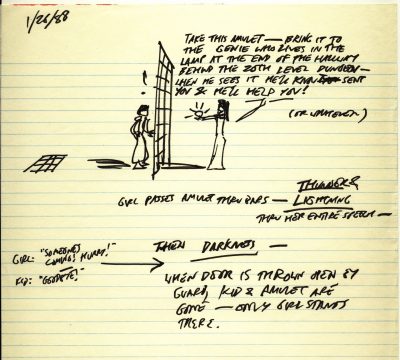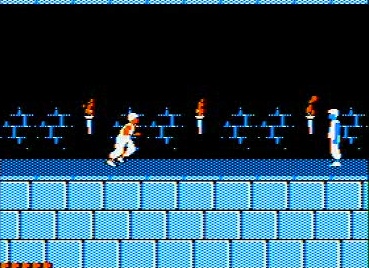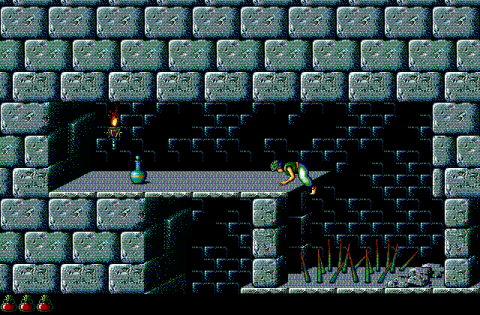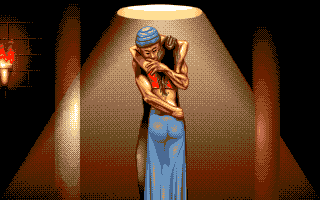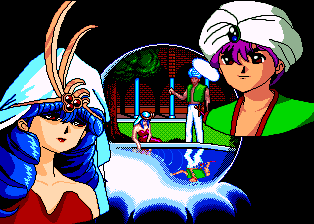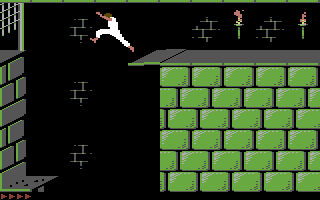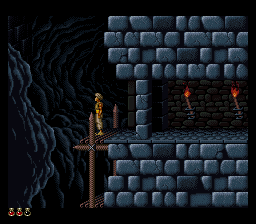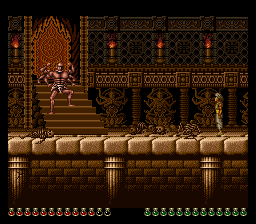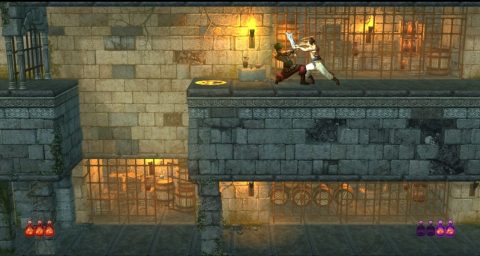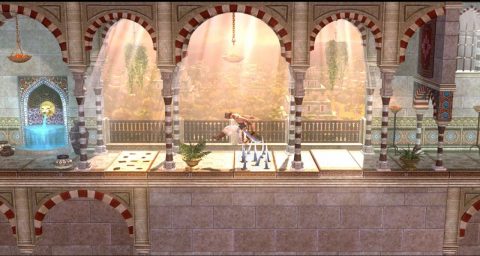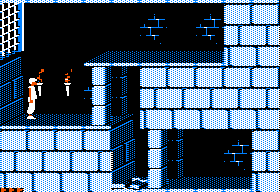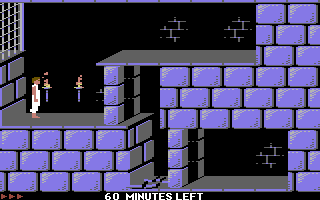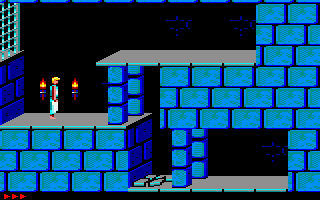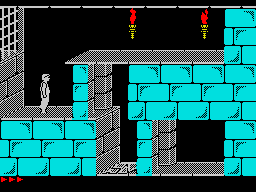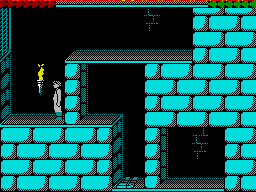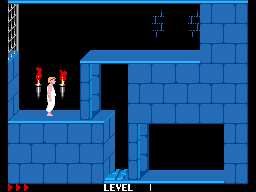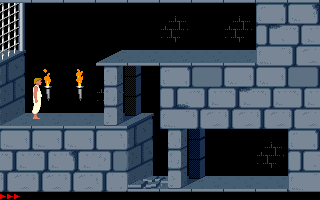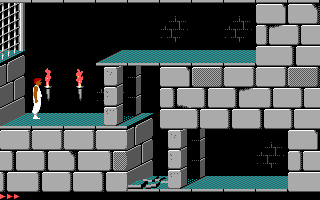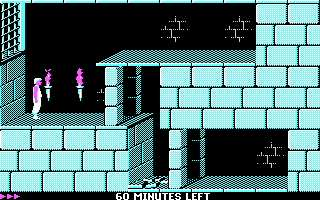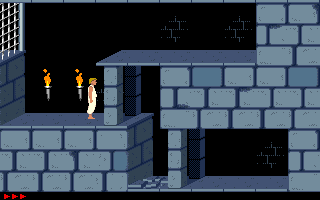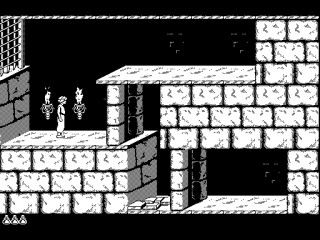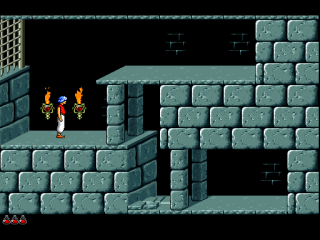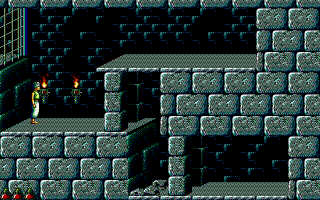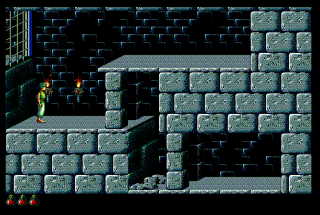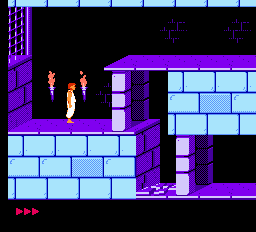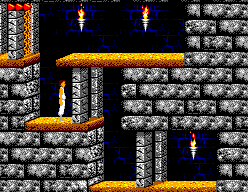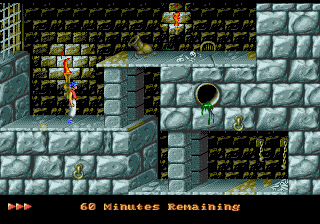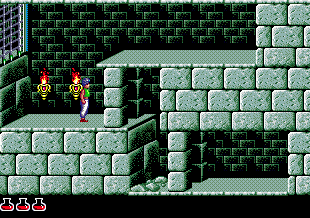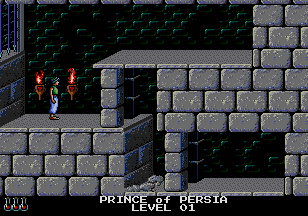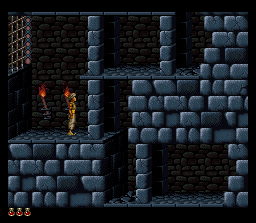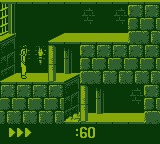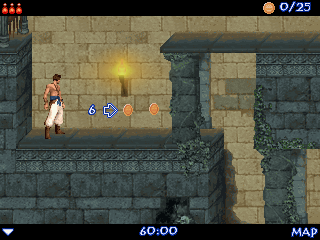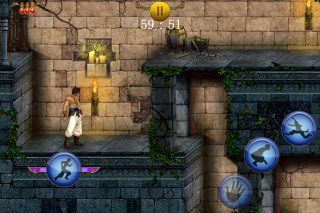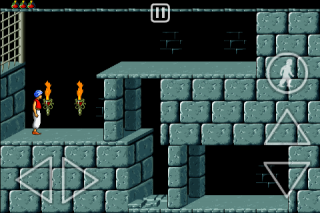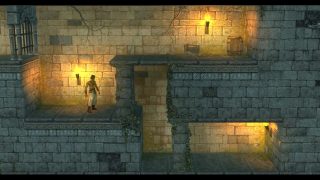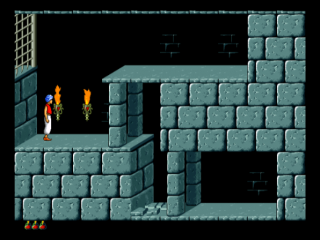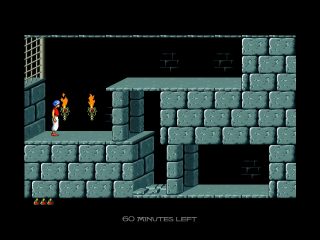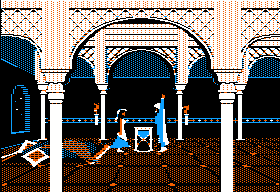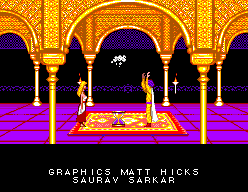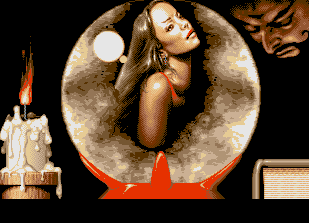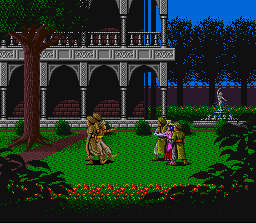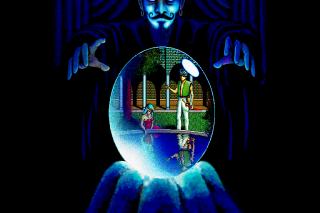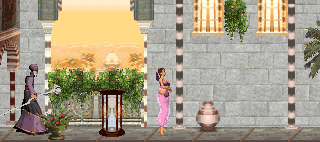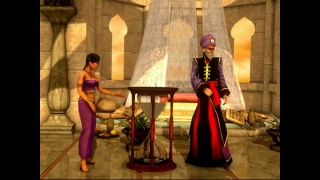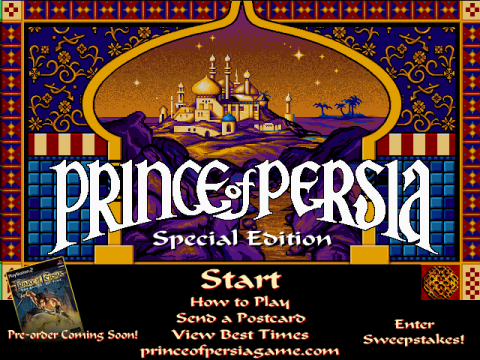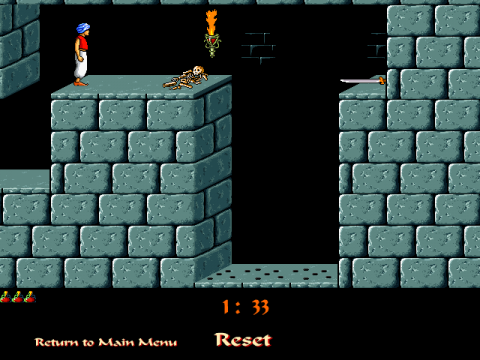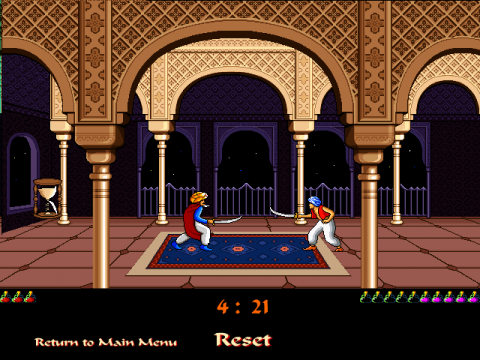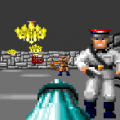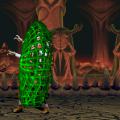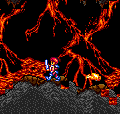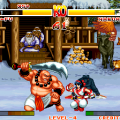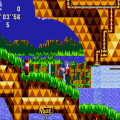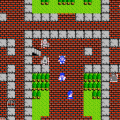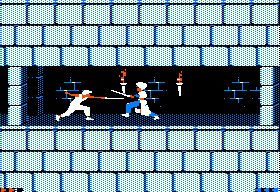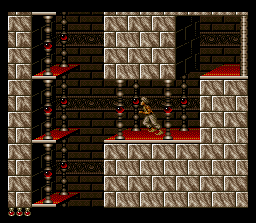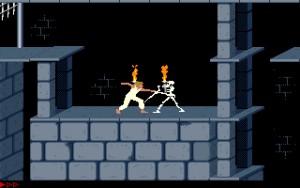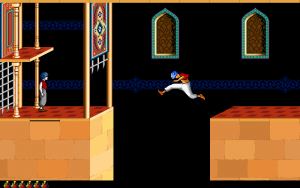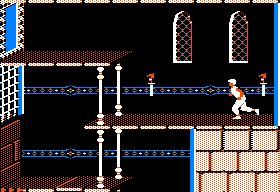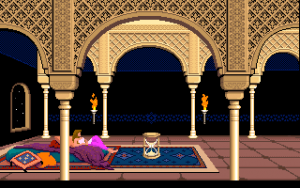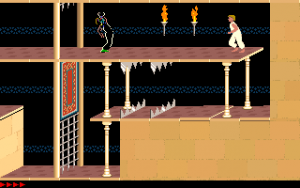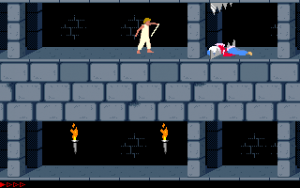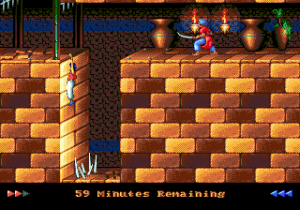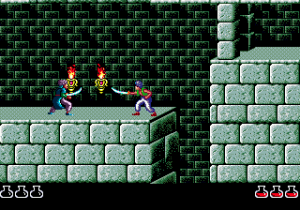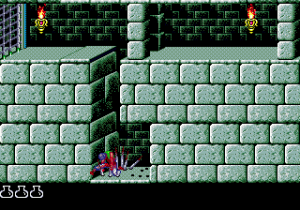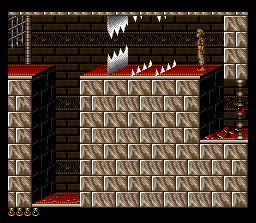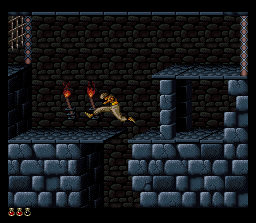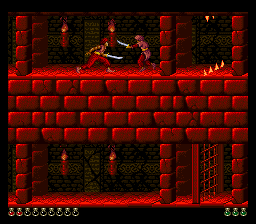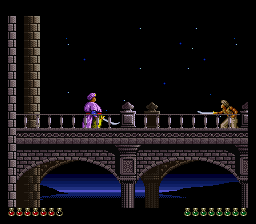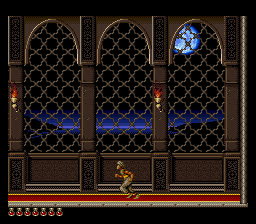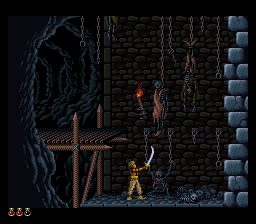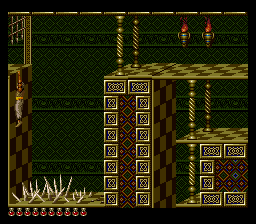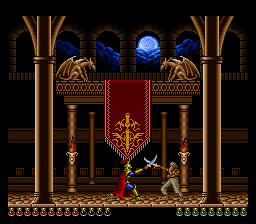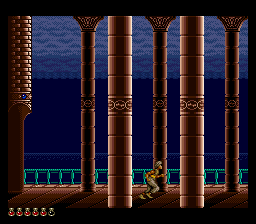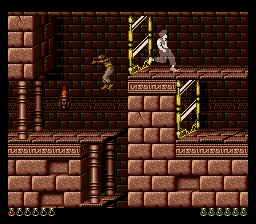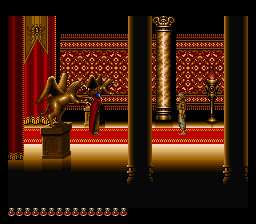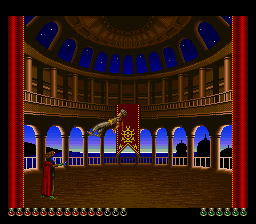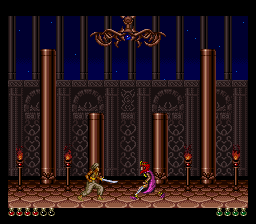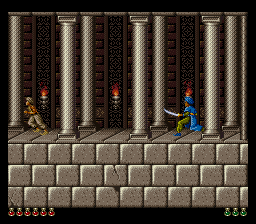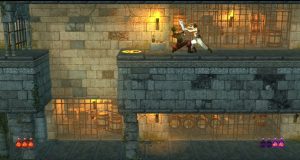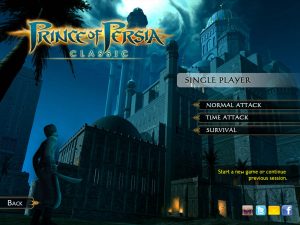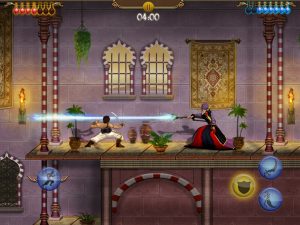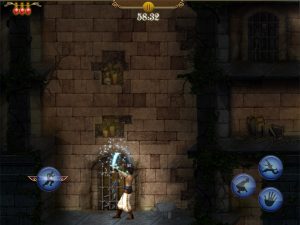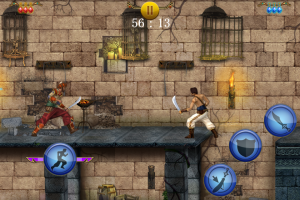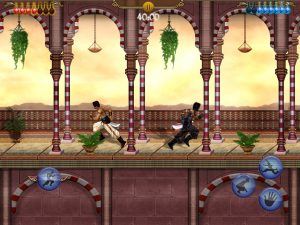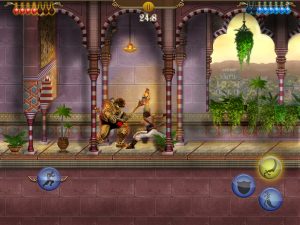- Prince of Persia
- Prince of Persia 2: The Shadow & The Flame
- Prince of Persia: Harem Adventures
- Prince of Persia 3D
- Prince of Persia: The Sands of Time
- Prince of Persia: Warrior Within
- Prince of Persia: The Two Thrones
- Battles of Prince of Persia
- Prince of Persia (2008)
- Prince of Persia: The Fallen King
- Prince of Persia: The Forgotten Sands (PS3/X360/WIN)
- Prince of Persia: The Forgotten Sands (Wii)
- Prince of Persia: The Forgotten Sands (Portable)
August 28, 1988
The videotaping with Robert came to an undignified halt when the battery pack in the rented camera abruptly died. At the time, I was hanging off the edge of a bus shelter at the North San Pedro Road freeway exit, hoping the cops wouldn’t show up, and realizing that hauling oneself up onto a ledge from a dead hang is harder than I’d thought. We’ll try again next week.
Prince of Persia was one of the great milestones for how video games were being made and perceived as a narrative form, but for a while there it almost didn’t get made. Then after it got made, it almost flopped. In summer 1985, not too long after his first game Karateka was released, a young game designer / aspiring screenwriter named Jordan Mechner first came up with the idea of a game in an Arabian Nights setting. By the end of the year, a contract was drafted with Karateka-Publisher Brøderbund, and Mechner had shot footage of his brother David performing various movements intended for the game – only the first of many recording sessions in Prince of Persia‘s development.
Mechner had first applied rotoscoping – that is, a live actor is filmed by a camera doing a variety of movements, and then an artist traces those images on a computer – for Karateka, and for his new game he would refine the technique. Even in the earliest demos, the hero of the game still frequently referred to as Baghdad (the title Prince of Persia was first thought up by Brøderbund’s producer for the game a year later) had remarkably fluid animation. He didn’t just jump up – he’d squat, leap into the sky and grab ahold of a ledge, swaying in the air before he pulled himself up and over. Considering most game characters at the time were lucky if they had more than three frames of movement animation, this was an extraordinary achievement. Getting the footage for the Prince’s athletic movement wasn’t always easy:
Active work on the code began on October 21, 1986 and Mechner was hopeful to finish the game by August of the following year. But after some initial progress, Mechner effectively put Prince of Persia on halt for a long time, due to a lack of motivation and being torn apart between working as a game designer and trying to get his career as a screenwriter going. His journal on November 20, 1987 reads:
Yesterday I went in to work for the first time since I can’t remember when. I booted up the game and looked at it. It was deeply depressing.
Going through the game’s code, he found himself hardly remembering any of it. But his long time friend Tomi Pierce (1953-2010) managed to convince him to pick up the pieces and go on:
“Think of the game as an old car you’re fixing up in your spare time,” Tomi suggested, urging me to resume work on it. This old car has an engine block that’s rusted solid. I can’t even think about how much work lies ahead.
Other friends supported the project as well: Robert Cook, designer of D/Generation contributed many ideas like the legendary mirror scene and helped with the recording of the remaining animations. Mechner got his father to compose the musical score, which mixed several styles of oriental influences and was maybe the first effectively done cinematic soundtrack in a video game. Both Pierce and Cook later worked with Mechner on the immensely innovative and underappreciated adventure game The Last Express.
At the end of a long and sometimes troubled development, Prince of Persia finally shipped in October 1989 for the Apple II. However, despite critics revering the game and everyone’s confidence that Prince of Persia would become a huge hit, the game initially didn’t do very well. The Apple II was all but a commercially dead platform. An IBM PC port followed soon, but Mechner soon found himself frustrated by more disappointing sales and Brøderbund’s total lack of marketing for the game. It even was de-listed at EB in September 1992, four months after the DOS version had come out. Only when the game was exceptionally well received in Japan and Europe (especially France) and converted to dozens of home computers and game consoles, Prince of Persia became the success it is known as today.
July 18, 1990
Florence thinks Prince is going to be a big hit in Europe. And some rather startling news (from Doug): NEC Prince has already shipped 10,000 units in Japan. Could that be?? It’s only sold 7,000 units each on Apple and IBM in the U.S. to date.
After the original came out on practically every gaming platform at the time and sold 2 million copies world wide, everyone involved was pumped to make the sequel Prince of Persia 2: The Shadow and the Flame, which offered much more detailed graphics and locales, although the gameplay remained the same. Prince of Persia had made a huge impact, influencing as highly esteemed titles as Flashback and Tomb Raider, but the series itself went under for a long time – the disappointing Prince of Persia 3D: Arabian Nights was widely ignored – until UbiSoft revitalized the franchise with their amazing The Sands of Time, which was still in 3D, but managed to capture all of the acrobatic glory of the original games and still managed to control exceptionally well. Since then, Prince of Persia has become one of UbiSoft’s mainstay franchises, with lots and lots of sequels and spin-offs.
Although he was not the primary game designer anymore, Mechner was involved with both Prince of Persia 3D and The Sands of Time. Since then, he hasn’t gotten involved with any more game sequels, but produced two Prince of Persia comic books and wrote the original screenplay that formed the basis for the 2010 movie adaption. In his journal, we can read about the moment when Jordan Mechner first caught fire for his new game, still in the very early concept stages:
August 28, 1985
Then a strange thing happened. I started getting images in my head of the characters: The Sultan. The Princess. The Boy. I saw the scenes in my mind as if it were a Disney movie.
Twenty-five years later, it is a Disney movie; And incidentally one of the most prolific video game series around.
Prince of Persia is one of the early attempts of telling a video game story like a movie would. Inspired by films like The Thief of Bagdad, Mechner deliberately borrowed elements from tales of The Arabian Nights – the Evil Grand Vizier Jaffar has double-crossed the Sultan in his absence and issues an ultimatum to the princess: “Marry Jaffar… or die within the hour.” The young man who happens to be romantically involved with the Princess is tossed into the dungeon to rot. Not intent on dying in captivity, he must escape and defeat the evil Jaffar, marry the girl and become heir to the throne of Persia.
Partially due to the Prince’s movements, the controls are just a little bit awkward. Pressing left or right will make the Prince sprint in that direction, while pressing up will jump. There’s an additional button which will let you tiptoe (useful for getting close to edges) and to grab onto ledges. Certain versions of the game include a jump button, allowing you to make running leaps or short hops much easier.
But Prince of Persia isn’t just all about making crazy jumps – there’s a good amount of thinking required to get through the levels. Most of these puzzles revolve around hitting switches to open doors, dashing through a veritable gauntlet of razor sharp traps, running over collapsing floors and otherwise performing incredible acrobatic manuevers to get to the end of each level. The fact that these tiny marathons are usually timed doesn’t make things any easier.
Mechner originally planned to make Prince of Persia a straight puzzle platformer, influenced by Lode Runner and Castles of Dr. Creep. (The game was also supposed to ship with a level editor, which got canned later on.) But eventually it became clear that the pure approach without any combat didn’t quite work out for the game. Gene Portwood of Brøderbund called it “an effect in search of a game.” Tomi Pierce put it even more directly:
November 11, 1988
“I like games where you can shoot things. Your game has no rewards except getting to the next level. It’s all survival and no triumph.” -Tomi
So he went back to the drawing board, snitched some frames from Errol Flynn and Basil Rathbone’s climatic fight in The Adventures of Robin Hood to rotoscope, and found a way to implement the guards despite the Apple II’s memory limitations. So thanks to Tomi and Robin Hood, Prince of Persia became the first to make fencing in a game just as exciting as watching it in a movie. After snagging a sword in the first level, the Prince is now often forced to let weapons speak against the vizier’s guards. These encounters seem extraordinarily difficult at first, but it’s just all about timing. The prince can either attack or parry with his sword, but so can his opponents. Sword fighting requires splendidly fast reflexes and a keen eye to determine when to defend and to strike. The guards start out pretty slow but get more vicious with each new level.
Early in the game, the Prince is forced to jump through a mirror, only to find his shadow separated from his body. “Shadow Man” was actually the first adversary ever conceived for the Prince, back when Mechner still thought he wouldn’t have enough memory to include distinctive enemy sprites. This evil doppelganger haunts the Prince until the final stages of the game, stealing potions and triggering traps, until the inevitable confrontation to reunite him with the Prince’s body. It’s a clever device, echoed in more recent games like Metroid Fusion and Metroid Prime 2, and even picked up on in Ubisoft’s third Prince of Persia game, The Two Thrones.
November 13, 1988
We’ll make the shadow man your opponent for the entire game. You’re competing for hit points. Each blow you deal him weakens him. Each power dot you eat makes you stronger. But if he gets there first and he eats it, he gets stronger. So when you face each other with crossed swords, the balance of power is not predetermined (as in Karateka), but is the result of your own actions thus far in the game.
Mechner’s lofty ideas for the shadow man didn’t quite pan out as planned. Every action of the Prince’s identical rival is scripted, and he only snatches a potion once to demonstrate is malicious intent. But that doesn’t diminish the impact of the short scenes involving him and the mouse the princess eventually sends to aid her would-be rescuer – at least not the first time. The element of stacking the odds in the Prince’s favor by drinking health-extending potions – an inspiration from Super Mario Bros. 2 – is still in the game, albeit without the competitive aspect.
May 9, 1989
Spent the day hard-wiring the shadow man into the level I built yesterday. It’s kind of a letdown. For over a year now, the shadow man has been this awesome idea that everyone gets all excited about when they hear it. Now, it’s just what it is. The unlimited potential has been replaced by the concrete reality of what I programmed today.
This time, there’ll be no time for me to tear it all down and reprogram it five more times, to try to more fully realize the dream. The hundreds of thousands of kids who I hope will play this game will encounter the shadow man just as I programmed him today. I hope he blows them away. I’m too close to it to be able to tell. If not, well, I blew it.
Most of the time, however, it doesn’t even matter how much health the Prince has, as most traps in the dungeon are deadly. Together with the cinematic approach to animation, this leads to the central problem of Prince of Persia – they make the game insanely hard. There’s always a bit of a delay to changed inputs as the animations play out, and it’s really easy to accidentally careen off a cliff or miss a jump or somehow make some little accident that results in the Prince getting skewered, sliced or otherwise killed in a bloody, gruesome manner. The Prince also frequently ends up getting stabbed to death by the guards, who can kill him in one blow if he happens to run into them without his sword drawn. Prince of Persia knows little of checkpoints, so dying means going back to the beginning of the level. There is no limitation to the number of tries, but the Prince only has 60 minutes to make his way through the dungeons and defeat Jaffar before his ultimatum to the princess is up. The game really isn’t that long. Without dying, it is theoretically possible to get through the thirteen levels with plenty of time to spare, but the timer is not reset when getting killed over and over, so it’s easy to run out of time. Getting a perfect run on a game like this is an achievement of monumental proportions.
And yet, when playing the levels over and over, a feel for the motions sets in eventually, and each playthrough becomes less difficult. With the patience to get comfortable with the unconventional controls and an appreciation for the beauty of the graphics, Prince of Persia will slowly reveal its rewards. Learning to love Prince of Persia means learning to admire every insane leap, every puzzle completed just in the nick of time as the gate snaps closed behind, every victory against some bastard guard. Once the seemingly imprecise controls are mastered, the game reveals itself as surprisingly systematic. The same amounts of steps is always required for the same jump length, so it’s always possible to calculate in your head if you’re going to make a certain jump or not. Likewise, there’s certain rhythm to the back-and-forth of the sword fights, allowing an experienced player to win every time. It’s a very old school kind of pleasure.
Prince of Persia’s native platform was the Apple IIc, a machine that was mostly known for infesting elementary schools with edutainment rather than being suitable for difficult action games. While the four color scheme may make the graphics seem primitive in still shots, all of the incredible animation was already in place – truly a remarkable achievement, regardless of some slowdown that occurs whenever there are moving objects besides the Prince on screen. The game has a few glitches, though. When sneaking past spike traps, it is important to keep the button pressed until the spikes have retracted, even if the Prince has already passed them, or else he still winds up dead.
Because 1989 was awfully late for an Apple game, both Brøderbund and Mechner were desperate to get a IBM PC version out as fast as possible, so it was ported in-house with the creator’s involvement, but not without its own share of troubles underway. This version introduced 256 color graphics that looked quite a bit nicer, in addition to improved music. Contracted Amiga and Atari ST versions followed soon. The latter had to make a few compromises in coloring, but on the Amiga it looks almost exactly like the PC version.
The game was also ported to more 8-bit computers, mostly popular machines in Europe in Europe: Amstrad CPC and the obscure British computer Sam Coupe. The same guys that created the latter also worked on a Spectrum version, but it got cancelled because the developer couldn’t find an agreement with Domark, licensing partner for the game in the UK (the Spectrum was commercially abandoned by then). The game made it onto Britain’s most popular home computer after all in 1995, in an unlicensed port programmed in Russia, although this version shrinks all screens by 2 tiles width. There have also been failed attempts to bring the game to indigenous Russian computers.
Ported by Arsys and published by Riverhill Soft, Prince of Persia also made it to the three major 16-bit computer platforms in Japan, the NEC PC-98, Fujitsu’s FM Towns and the X68000 by Sharp. The former two look exactly the same, but the FM Towns version was released on CD and features a redbook audio soundtrack, while Prince of Persia on the NEC platform has a few extra menus that allow setting the speed of both the platforming and fighting gameplay. These ports make heavy use of dithering effects to conceal the 16-color palette, which makes them look rather ugly on modern monitors. The X68000 uses more colors, but also suffers from this effect to a smaller degree. For some reason it also seems to run in a very high resolution with huge black borders.
The PC Engine port is clearly based on this branch of conversions – it even includes the speed option. But it has a color palette that’s better suited for posterity and more fluid gameplay. Unsurprisingly, it is the only version of this group that made it stateside on TurboGrafx-16 CD. All of these Japanese versions allow saving the game at each level, removing some of the stress that came with the requirement of completing it in one more or less flawless session. They also used a new set of graphics, first introducing the Prince’s new outfit with the turban and vest. Mechner was quite impressed when he saw them, so much that they were used as a basis for the Macintosh version.
March 5, 1990
Saw the new NEC 9801 Prince from Japan. It’s beautiful. It blew me away. What a great feeling. As Lance said: “It’s like seeing the movie version of a book you wrote.”
The last American-made home computer port was even better looking, with redrawn high-res graphics and a new color scheme. It contains three graphic sets, for monochrome as well as higher and lower resolution color monitors. In either mode, the graphics are very detailed, but appear a little bit too clean, creating a somewhat sterile impression compared to the busy wall textures of other versions. The Macintosh version is included as a bonus with Prince of Persia: Sands of Time, although it has been downscaled to fill about half of the screen for whatever reason. The Forgotten Sands on the Wii also has it, with a size somewhat closer to full screen, but not quite.
But there were even more console ports. Initially, Sunsoft hat tried to acquire the rights for Nintendo adaptions shortly after the game came out, but the deal didn’t work out, supposedly due to Brøderbund’s inaction. In the end, both the Game Boy and NES versions were made by Virgin Interactive almost years later. Given the sensitivities of the market at the time, most of these had the blood toned down to varying degrees. On the other hand, Prince of Persia was probably the only game ever whose cover got sexed-up for the Nintendo ports. (The original cover was supposed to look more like that, but the female marketing manager at Brøderbund opposed the Princess’ cleavage.)
The NES port looks remarkably like the PC version, although a few levels are broken up into multiple stages and the screens have to scroll a little, since they can’t fit entirely on the screen. The Game Boy version doesn’t have that problem because everything is scaled to size, anyway, but because of the lack of colors all levels look the same. (Nowadays it is worth mentioning that the sound for both versions isn’t properly emulated in most Game Boy emulators.) In 1999 Red Orb Entertainment dusted off the latter version for a Game Boy Color release, which adds a short training level, besides the obligatory coloring. This was later also made available on the 3DS eShop.
UK publisher Domark was responsible for most of the Sega versions. These have incredibly amusing cover art, with the Prince bearing more than a vague resemblance with Luke Skywalker. The Sega Master System and Game Gear version look much better than their Nintendo 8-bit counterparts, although there’s an annoying fade between screens, and the animation feels a little weird.
While all console ports support multiple button layouts, the Domark and Virgin versions don’t offer the option to press diagonally upward for forward jumping in favor of a separate jump button, which may be what most console players are used to, but it doesn’t fit together well with the game’s feel. Another flaw shared by them is the combat being a hectic mess, a far cry from the systematic original, which was difficult to handle but quite possible to master. Here it is hard to prevent things from degrading into random button mashing.
The Genesis version probably has the most detailed graphics of them all. Lots of extra touches are added here and there, despite the still limited color palette. Unfortunately, the fading from the Sega Master System version remains, making some of the multi-screen running jumps unnecessarily difficult. The terrible music score is an embarrassment to the Genesis’ FM chip. When released for the Mega Drive in Europe, this version was enhanced with a new short intro animation of the Prince getting kicked down a set of stairs and the musical score playing throughout the game. Most of all, the Mega Drive version features four all new levels and time extending potions to make up for the longer journey.
The Sega CD version is an entirely different port. It belongs to the same family of conversions as the Japanese computer versions. It has the speedup option, redone graphics, a few different CD music tracks than the PC Engine version, and cool new anime-style scenes to accompany the intro.
The Prince’s appearance on the iOS appstore has been a bit confusing over the years. At first, the classic Macintosh version appeared in 2010, but it was eventually pulled from the store and replaced with an enhanced version of Prince of Persia Classic (see next page) in 2012. The original game subsequently underwent some interface changes and was relocated as Prince of Persia Retro. Only the Classic version has also been released for Android devices later that year.
Another recent port of the original game is once again unofficial: Indie programmer Mr. SID finally brought the game to a vintage platform that was long missing out on the game – the Commodore 64. The port is quite an impressive feat, based on the original Apple II source code documentation and with graphics resembling the IBM PC version. It only runs from custom made flash cartridges, circumventing the terrible load times of the C64’s floppy drive. It does work with certain emulators, though, and is freely available for download. There is also a playable 1-level demo of the game for various programmable calculators, which appears to be based on the Game Boy version.
Except for the few extra levels on the European Mega Drive, the only significant differences between all versions of Prince of Persia are cosmetic. Not so the SNES version. It was published by NCS in Japan and Konami in the rest of the world, but the developer behind it was once again Arsys, who had already blessed three Japanese computer platforms with the Prince. Apparently the guys had enough of porting the same game over and over again and added all kinds of new content.
For starters, there is now a separate training mode that walks you through some basic traps and concepts step-by-step. There are no tutorial messages, but the first of five training stages doesn’t even have any deadly fall. It gets gradually more dangerous, but things remain focused and easier than even the first normal level. Aside from a new entrance screen, the first level starts out exactly like it would on the Apple II, but before the Prince can get his hands on a sword, he needs to descent deep into the caves beneath the castle.
Most levels have small additions and variations like this. Then there’s an entirely new area of the castle appended in front of the former stage four, and another one immediately after that. At the point where the Prince’s shadow finally drops his fleshy counterpart down a pit, it doesn’t just lead to just another dungeon like before, but a hellish magma cave where the air billows from the heat and many skeletons attack – it’s almost as if this part was inspired by The Shadow & the Flame, if it wasn’t actually released before Brøderbund’s sequel. All in all, the entire map is roughly twice as large as it used to be, but to compensate Jaffar’s hourglass now contains two hours worth of sand.
The new environments also bring new enemies: In the palace towers the Prince has to defend himself against amazon warriors and heavily armored royal guards, and deep within a temple with Egyptian and Hindu looking murals awaits a six-armed giant who jumps around the screen and makes it rain skulls. Jaffar’s black magic was very understated in the first game – he summoned an hourglass of thin air and was presumably responsible for the attacking skeletons and the Prince’s shadow, but that was the extent of his trickery. Now he is a powerful sorcerer who can levitate the Prince, only to smash violently to the ground.
Regular enemies, on the other hand, are a bit less mobile than they used to be. Formerly they would go after the Prince after pushing him down to the next lower level, but no they just keep standing there blocking the ledge, rendering the stage unwinnable if there is no other way around.
Additional traps also make the Prince’s life more difficult. The heavy crushers that are first seen smashing a skeleton to dust work pretty much like the bladed doors, but conveyor belts (in ancient Persia?) can be a real nuisance during combat. Flames spring forth in regular intervals from cracks in the floor in the deep catacombs, and later on there are swinging beams that can only be passed by shoving along in a crouched position – a maneuver that seemed more like a glitch in previous versions but could be used to duck through closing gates in the last moment.
While the graphics cannot hope to be as detailed as the Macintosh version, Arsys’ remake easily beats Brøderbund with the sheer power of variety. Instead of two meager alternating wall templates there is a new one after every two or three levels. It’s still mostly castle walls, but Arsys did their best to include a few more vistas to the night sky, and there are added details like the mortal remains of former prisoners in the dungeon. The music is a bit quieter than the CD versions, but it fits the mood of the game splendidly.
Prince of Persia on the SNES is just bigger, better and better than any version before it. If you’re going to a pick only one version of the game to play, it should really be this one.
In 2007, a remake of Prince of Persia was released on Xbox Live Arcade, soon followed with the PS3 port as Prince of Persia Classic. Although all of the graphics are 3D (and done in the style of The Sands of Time), the gameplay is still all 2D. The controls are fairly faithful, but in some cases have actually been tightened up to be more responsive. When trying to jump up to a ledge, the Prince now automatically turns around if necessary, and it’s easier to turn around without immediately running in the opposite direction. This might actually throw off people used to the timing of the original versions, but it makes for generally much better control. The ability to jump and bounce off walls from the newer games has been included, but since the levels remain exactly the same there is not much use for it.
The one aspect that actually feels clumsier compared to the original is the combat. The early enemies are much too easily fooled by blocking and counterattacking so fighting them is devoid of any challenge, but later enemies become so apt at blocking themselves that combat turns into an endless exchange of blocks and parries. Especially the few giant enemies that are added in the mix are a major pain, and actually getting through their defenses feels completely random.
Presumably to avoid putting off modern audiences, the game has been made much easier. The Prince is now guided by a magic sparkle that always shows the optimal way to the next target location, which can be switched off in the options. Enemies don’t strike the Prince down before he gets a chance to draw his sword, anymore. Floor switches are now marked in bright colors – those that open doors are yellow, while those that close them are red. There are checkpoints in each stage that start the Prince with full health after dying, so health management is much less of an issue. There is still a timer counting down, but the game doesn’t actually end when you run out of time – you just get a shorter ending after defeating Jaffar. For those who’d actually like to have a challenge, there is also a Time Trial mode available. Even harsher is the Survival mode, which demands to play through the entire game without dying.
Based on this version is also the mobile port by Gameloft. The characters and stages are converted into pre-rendered 2D graphics, much like the Donkey Kong Country series, and the controls have been reworked even more to make up for the typical issues that come when playing a game on a phone keypad, but there’s another major issue, depending on the device it is played on: Most cell phones have a higher vertical resolution with a very narrow horizontal, which this game just wasn’t made for.
In February 2012, Prince of Persia Classic arrived on iOS and later that year on Android, with dungeon maps and added FMV story cutscenes. The graphics are still only 2D, but look much better than on traditional mobile phones. The controls offer the choice between a virtual joystick, directional buttons and a slider. The latter two don’t have a separate “up” direction, which sometimes makes it difficult to jump forward while standing below a ledge.
Links:
Jordan Mechner’s Homepage Offers eBooks of the author’s journals 1982-1993.
Prince of Persia Ubisoft’s official page for the most recent game.
Prince of Persia Classic Game Postmortem at the GDC Vault.
Screenshot Comparisons
Intro Comparisons
Prince of Persia Special Edition – Browser (2003)
To promote their upcoming revival of the Prince of Persia series, Ubisoft launched a tiny Flash remix of the classic 2D game a few months prior. The Special Edition replicates the gameplay of the original, but features a completely new stage. The prince has only eight minutes to find and defeat Jaffar before he unleashes the Sands of Time, but that is more than doable given the size of the game. Prince of Persia Special Edition uses the graphics of the Macintosh version. Ironically it is the only game at the time to reproduce them in the original resolution, at least if the Flash embed is configured properly.
The physics don’t work out exactly as faithful, though. It’s even easier to slip past your target and die than it ever was. Some of the puzzles have rather questionable design, too. There’s a gate that keeps opening and closing as long as the Prince is standing on the switch, but closes immediately once he rushes towards the gate. The only way to get through is by waiting until just the exact moment before it closes, dash forward and duck through in the last instance – no puzzle in the original game required such precise timing and speed.
Like in the very first stage back in 1989, the Prince first has to find his sword to be able to fight the guards. He can easily run past them unarmed, but that only gets him slaughtered in the fight against Jaffar. The Grand Vezir has an obscene amount of health – ten flasks versus the Prince’s three – but the AI is so bad that this is not much of a problem. While it might have been neat as a free promotion in 2003, there’s not much reason going back to Prince of Persia Special Edition now, as neither the functionality nor the level design is particularly good.
